The evolution of Filipino art forms reflects a rich tapestry of cultural exchange and historical transitions. Under American influence, the definition of art shifted from traditional crafts to more complex expressions of creativity. This period marked a significant turning point in the Philippines’ artistic journey.
Native Filipino cultural expressions blended with colonial legacies, creating a unique fusion. This interplay shaped the concept of art, transforming it into a powerful medium for storytelling and identity. From weaving to painting, these forms became symbols of resilience and innovation.
As we explore this historical journey, we’ll uncover how key transitions influenced local practices. The importance of creative expression in society will also be highlighted, showcasing its role in shaping cultural heritage.
Key Takeaways
- American influence reshaped the definition of Filipino art.
- Native traditions blended with colonial legacies.
- Art became a medium for cultural storytelling.
- Key transitions influenced local artistic practices.
- Creative expression plays a vital role in society.
Introduction: Setting the Stage for Change
The Philippines has a vibrant cultural history shaped by its indigenous roots and foreign influences. From weaving to pottery, local craftsmanship has long been a cornerstone of Filipino identity. These traditions laid the foundation for a dynamic creative landscape.
As the 20th century approached, the arrival of American rule brought significant shifts. The blending of local and foreign ideas reshaped the concept of creative expression. This period marked a turning point in the evolution of Filipino work art.
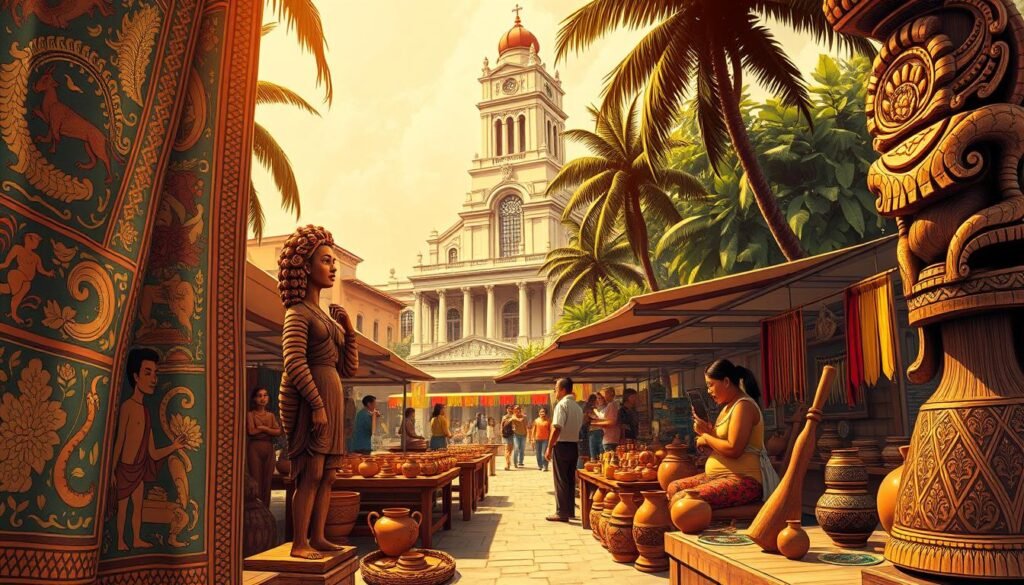
Overview of Filipino Art
Before American influence, Filipino creative practices were deeply tied to daily life and rituals. Indigenous techniques in weaving, carving, and pottery reflected the community’s connection to nature and spirituality. These forms were not just decorative but served practical and symbolic purposes.
Over time, these traditions began to merge with external influences. The result was a unique fusion that preserved local identity while embracing new ideas. This interplay set the stage for the modern Filipino creative scene.
The Impact of American Rule
American rule introduced new educational systems and cultural values. These changes encouraged Filipinos to explore Western techniques and styles. Schools and institutions played a key role in promoting these new forms of expression.
The blending of local and foreign ideas led to a cultural synthesis. Artists began to experiment with themes and methods, creating works that reflected both tradition and innovation. This period also saw the rise of public appreciation for creative practices, transforming their role in society.
| Aspect | Pre-American Influence | Post-American Influence |
|---|---|---|
| Techniques | Indigenous methods like weaving and carving | Integration of Western painting and sculpture |
| Themes | Nature, spirituality, and daily life | Exploration of identity, history, and modernity |
| Role in Society | Practical and symbolic purposes | Public appreciation and cultural expression |
This cultural exchange not only enriched Filipino creative practices but also strengthened their role in shaping national identity. The legacy of this period continues to inspire artists and audiences alike.
Historical Context of American Influence on Filipino Culture
The arrival of American rule in the Philippines brought profound cultural shifts. This period marked a turning point in the evolution of Filipino creative practices. The blending of local traditions with foreign ideas reshaped the cultural landscape, influencing everything from daily life to artistic expression.
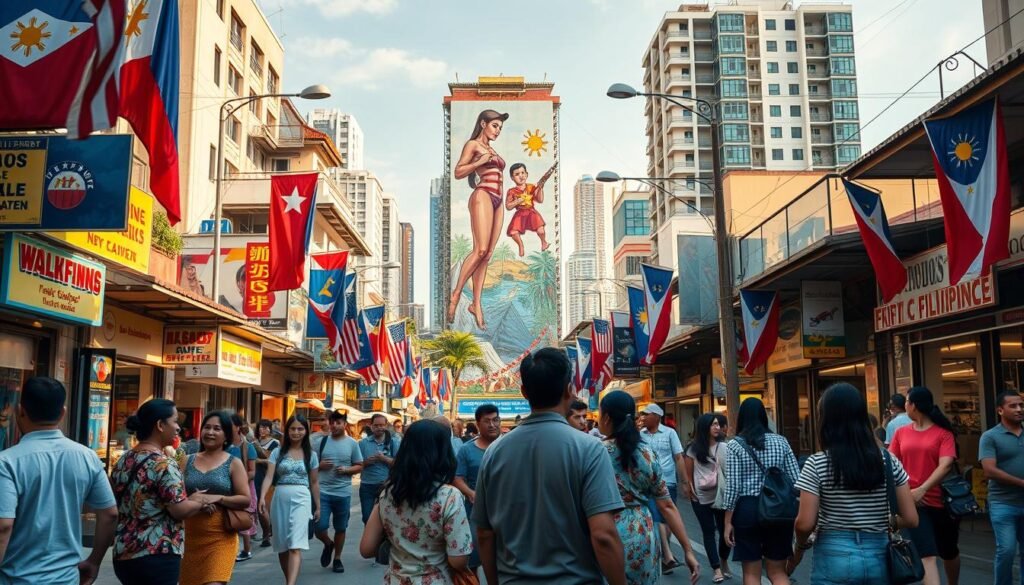
Colonial Legacy and Transition
American rule introduced new educational systems and cultural values. These changes encouraged Filipino artists to explore Western techniques and styles. Schools and institutions played a key role in promoting these new forms of expression.
The blending of local and foreign ideas led to a cultural synthesis. Filipino artists began to experiment with themes and methods, creating works that reflected both tradition and innovation. This period also saw the rise of public appreciation for creative practices, transforming their role in society.
Early Encounters and Adaptations
Early encounters between Americans and Filipinos had a lasting impact on cultural practices. The transitional period saw the gradual adaptation of Western techniques in local art. Prominent artists emerged as mediators between traditional methods and modern practices.
Over the century, the object of artistic creation evolved significantly. From practical tools to symbolic expressions, Filipino artists redefined the purpose of their work. This shift reflected broader changes in society and cultural identity.
By the mid-20th century, Filipino artists had established a unique style that blended indigenous and foreign influences. This fusion continues to inspire contemporary creators, preserving the legacy of this transformative period.
Key Elements of American-Influenced Filipino Art
The fusion of American and Filipino creative ideals reshaped the cultural landscape. This period saw a dynamic interplay between local traditions and Western techniques, giving rise to new forms of expression. The integration of these influences transformed the way Filipinos approached creativity, blending tradition with innovation.
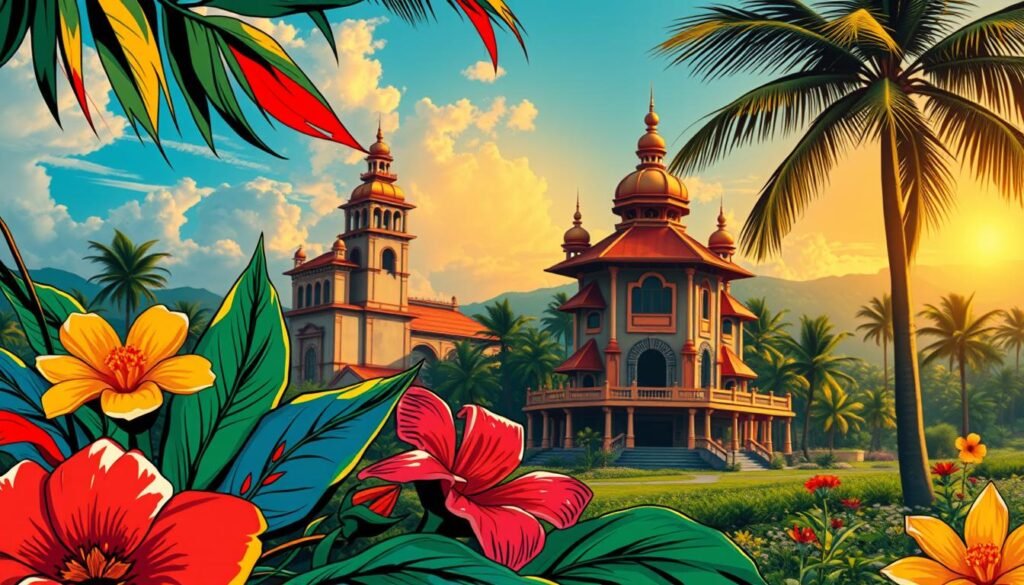
Visual Aesthetics and Expression
American ideals introduced a fresh perspective on visual aesthetics. Filipino artists began to experiment with Western techniques, such as realism and abstraction. This shift allowed for a broader range of expression, enabling creators to explore themes of identity, history, and modernity.
The blending of traditional and modern elements became a hallmark of this era. Indigenous motifs were reimagined through a contemporary lens, creating a unique visual language. This synthesis not only enriched Filipino aesthetics but also strengthened its role in cultural storytelling.
Influence on Performance Art
Performance art emerged as a powerful medium for cultural dialogue. Inspired by figures like Marcel Duchamp, Filipino artists embraced radical ideas that challenged conventional norms. This new form of expression allowed for innovative ways to address social and political issues.
The evolution of performance art reflected a broader cultural shift. It became a platform for exploring Filipino identity in a global context. This medium continues to inspire contemporary creators, preserving the legacy of this transformative period.
Through visual aesthetics and performance, American influence left an indelible mark on Filipino creativity. These elements remain central to the country’s artistic discourse, showcasing the enduring impact of cultural exchange.
Evolution of Visual Art in the Philippines
The visual landscape of the Philippines underwent a dramatic transformation during the American colonial period. This era saw the blending of traditional Filipino techniques with Western methods, creating a unique fusion that redefined creative expression. From painting to sculpture, these changes left a lasting impact on the country’s artistic identity.
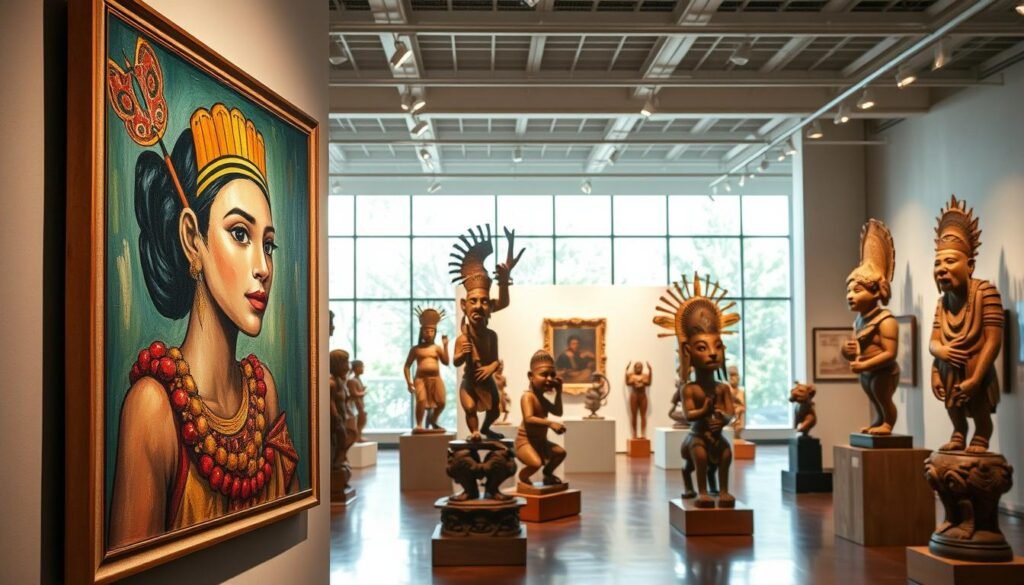
Painting and Sculpture Developments
During the American period, Filipino artists began to explore Western styles like realism and abstraction. Techniques such as oil painting and bronze casting gained popularity, allowing for more detailed and expressive work. Notable examples include Juan Luna’s Spoliarium, which won a gold medal at the 1884 Madrid Exposition, and Mariano Madriñan’s Mater Dolorosa, a celebrated sculpture from the late 19th century.
These developments challenged traditional methods, encouraging artists to experiment with new themes and materials. The result was a dynamic shift in the way Filipinos approached visual expression, blending local motifs with global influences.
Innovations in Printmaking and Mixed Media
Printmaking also saw significant advancements during this period. Techniques like woodcut engraving and lithography became popular, as seen in the first book printed in the Philippines, La Doctrina Christiana. These methods allowed for the mass production of artistic work, making it more accessible to the public.
Mixed media emerged as a powerful tool for creative expression. Artists began combining traditional materials like wood and clay with modern elements such as metal and glass. This approach not only expanded the possibilities of artistic work but also reflected the evolving cultural landscape of the Philippines.
| Aspect | Traditional Techniques | Modern Techniques |
|---|---|---|
| Materials | Wood, clay, natural pigments | Metal, glass, synthetic paints |
| Methods | Hand-carving, weaving | Bronze casting, lithography |
| Themes | Nature, spirituality | Identity, modernity |
The evolution of visual practices in the Philippines highlights the balance between technical proficiency and creative work. This period not only transformed artistic methods but also strengthened the role of visual expression in shaping cultural identity.
American Educational Reforms and Artistic Practices
American educational reforms played a pivotal role in shaping Filipino creative practices. The introduction of Western methods into local schools transformed the way artists were trained. This shift marked a significant transition from traditional practices to formal education in creative expression.
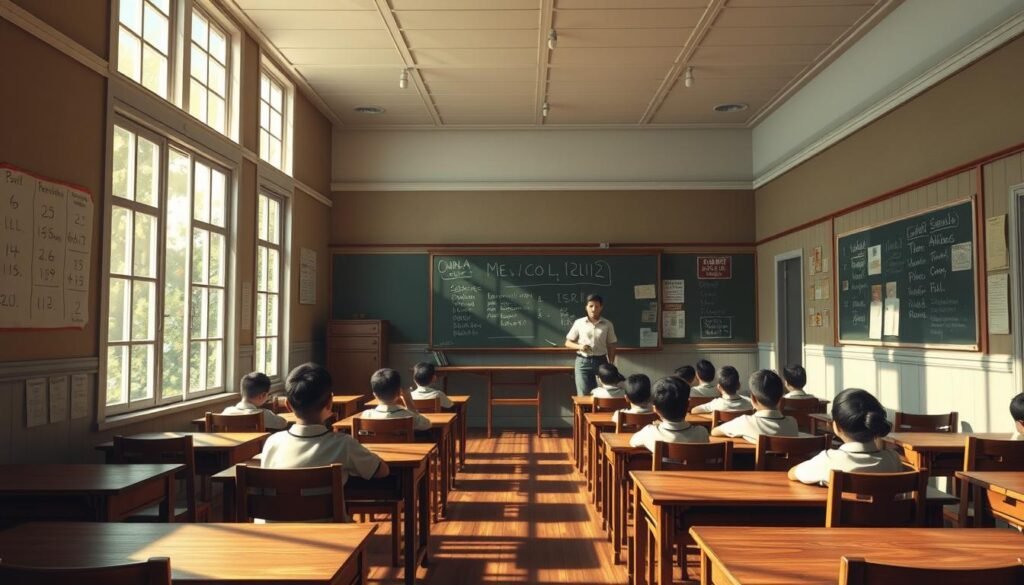
Educational institutions became key players in integrating Western techniques into the study of creative disciplines. Schools and academies adopted curricula that blended local traditions with global influences. This approach allowed Filipino artists to explore new themes and methods, enriching their practice.
The transition from informal training to structured education was a turning point. Academic institutions provided resources and mentorship, nurturing talent and fostering innovation. This shift not only improved technical skills but also elevated the role of creative expression in society.
One notable example is the establishment of art academies that emphasized Western techniques like realism and abstraction. These institutions became hubs for experimentation, where artists could refine their craft. The integration of these methods into formal education helped establish new art forms in the Philippines.
Reforms also influenced the public’s appreciation of creative works. As education expanded, so did the audience for artistic expression. This growing appreciation encouraged artists to push boundaries and explore new ideas. The legacy of these reforms continues to shape the Filipino creative landscape today.
Integration of International Art Movements
The global art movements of the 19th and 20th centuries left a lasting imprint on Filipino creative expression. As the Philippines opened up to international influences, artists began to adopt and adapt styles like Impressionism and Modernism. These movements introduced new ways of seeing and representing the world, blending seamlessly with local traditions.
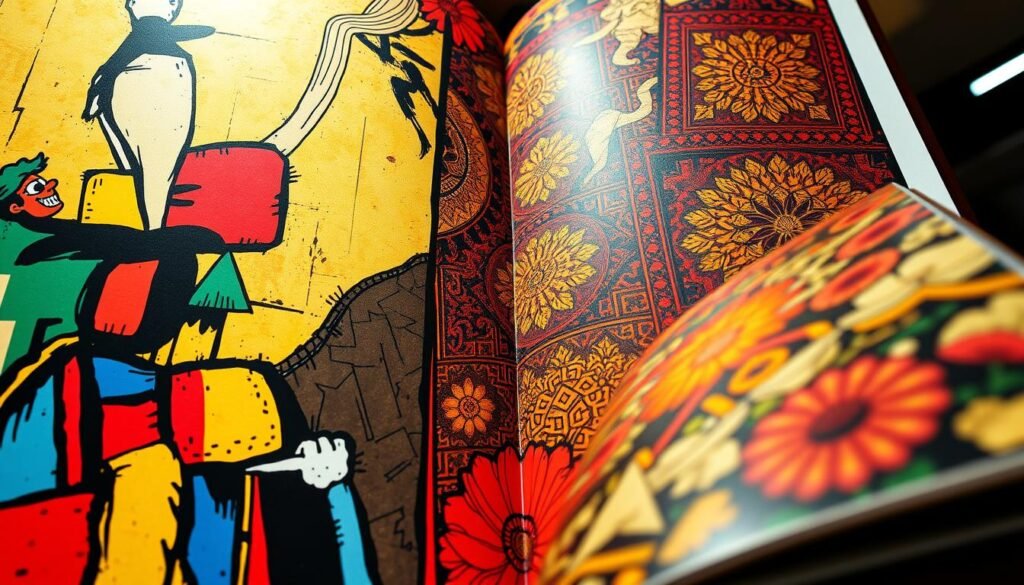
Impressionism and Modernism in a New Context
Impressionism, with its focus on light and color, found a unique place in Filipino artwork. Artists like Fernando Amorsolo used these techniques to capture the vibrant landscapes and daily life of the Philippines. The result was a fresh interpretation of local scenes, infused with a global aesthetic.
Modernism, on the other hand, encouraged experimentation and abstraction. Filipino creators embraced this movement to explore themes of identity and modernity. The blending of traditional motifs with abstract forms created a distinctive visual language that resonated with both local and international audiences.
Adaptations in Local Techniques
Local techniques were reimagined through the lens of global trends. For example, traditional weaving patterns were incorporated into modern design, creating a fusion of old and new. This approach not only preserved cultural heritage but also pushed creative boundaries.
Printmaking also evolved, with artists adopting Western methods like lithography. These techniques allowed for the mass production of artwork, making it more accessible to the public. The result was a democratization of creative expression, bridging the gap between high art and everyday life.
The integration of international movements into Filipino art reflects a dynamic cultural exchange. This cross-pollination of ideas continues to inspire contemporary creators, showcasing the enduring impact of global influences on local practices.
Celebrated Filipino Artists Inspired by American Ideals
The 20th century marked a transformative era for Filipino creators, deeply influenced by American ideals. This period saw the rise of pioneering painters and sculptors who blended native traditions with Western techniques. Their works not only redefined fine art in the Philippines but also shaped the nation’s cultural identity.
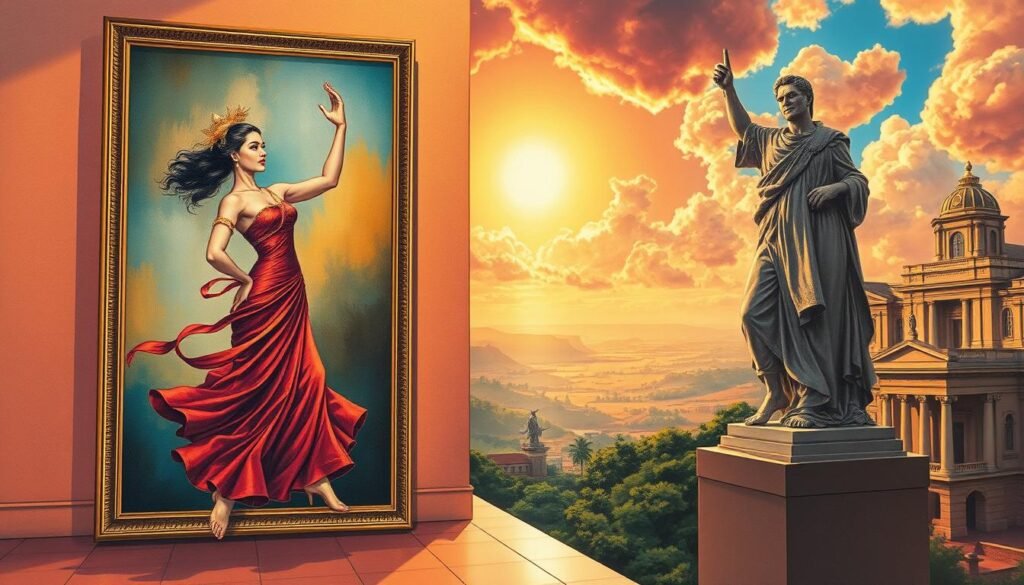
One of the most prominent figures was Fernando Amorsolo, the first National Artist of the Philippines. Known for his mastery of light and color, Amorsolo’s paintings captured the essence of Filipino rural life. His works, such as Planting Rice, became iconic representations of the country’s heritage.
Victorio C. Edades introduced modernism to the Philippines, challenging traditional norms. His painting The Builders is recognized as the first modernist work in the country. Edades’ bold approach inspired a new generation of artists to explore abstract and experimental styles.
Guillermo Tolentino, a National Artist for Sculpture, left an indelible mark with his monumental works. The Oblation at the University of the Philippines and the Bonifacio Monument are testaments to his skill and vision. Tolentino’s sculptures symbolize the nation’s struggle and resilience.
Napoleon Abueva, another celebrated sculptor, integrated functional and aesthetic qualities in his works. His Cross at Mt. Samat, the tallest in Asia, stands as a symbol of faith and unity. Abueva’s innovative approach redefined the term of sculpture in the Philippines.
| Artist | Contribution | Notable Work |
|---|---|---|
| Fernando Amorsolo | Master of light and color | Planting Rice |
| Victorio C. Edades | Pioneer of modernism | The Builders |
| Guillermo Tolentino | Monumental sculptures | Bonifacio Monument |
| Napoleon Abueva | Innovative sculptural techniques | Cross at Mt. Samat |
These artists not only elevated the status of fine art in the Philippines but also inspired future generations. Their works continue to be celebrated for their cultural and historical significance, showcasing the enduring impact of American ideals on Filipino creativity.
Fusion of Traditional and American Artistic Techniques
The blending of traditional Filipino techniques with American methods created a dynamic fusion in creative expression. This interplay allowed artists to explore new themes while preserving their cultural heritage. The result was a unique world of artistic innovation that continues to inspire today.
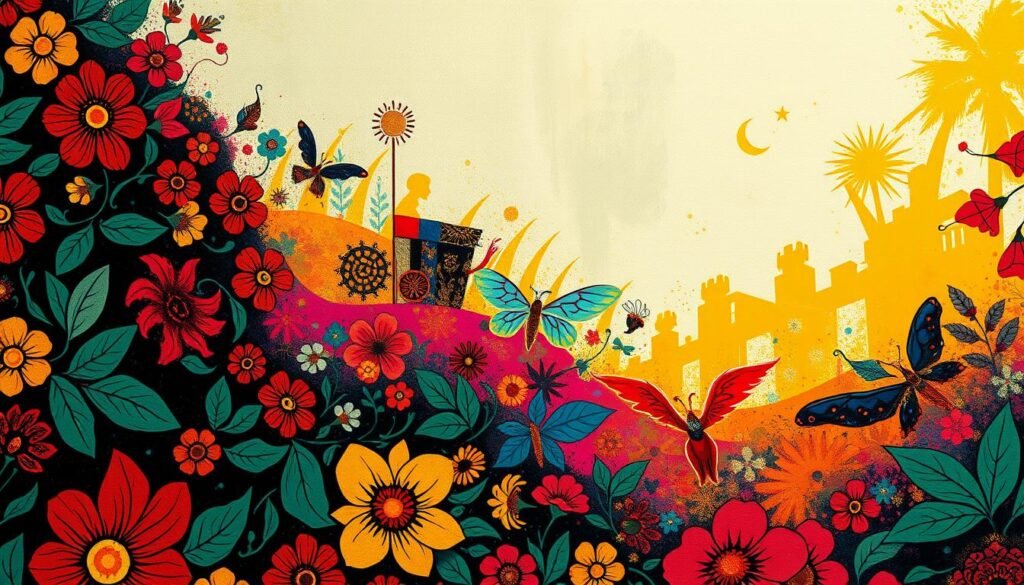
Revitalizing Indigenous Methods
Filipino artists have found ways to revitalize indigenous methods by integrating them with modern techniques. For example, traditional weaving patterns are now used in contemporary content, creating a bridge between the past and present. This approach not only honors ancestral practices but also gives them a new purpose in today’s society.
Efforts to preserve indigenous techniques often involve community workshops and educational programs. These initiatives ensure that traditional skills are passed down to future generations. By blending old and new, artists create works that resonate with both local and global audiences.
Embracing New Media Trends
The rise of new media has opened up exciting possibilities for Filipino creators. Digital tools and platforms allow artists to experiment with innovative forms of expression. This trend reflects a broader world of artistic exchange, where boundaries between traditional and modern content are increasingly blurred.
Artists are also using technology to reach wider audiences. Social media, for instance, has become a powerful tool for sharing their work. This shift not only enhances visibility but also fosters a deeper appreciation for Filipino creativity on a global scale.
| Aspect | Traditional Techniques | Modern Adaptations |
|---|---|---|
| Materials | Natural fibers, clay, wood | Digital tools, synthetic materials |
| Methods | Hand-weaving, carving | 3D printing, digital design |
| Purpose | Cultural preservation | Global artistic exchange |
This fusion of techniques highlights the evolving purpose of art in the Philippines. By merging traditional and modern methods, artists create works that are both culturally significant and globally relevant. To learn more about the roots of Filipino creativity, explore this guide to ancient Filipino scripts.
Architectural and Design Innovations in a Changing Society
Architectural design in the Philippines evolved significantly under American influence. This period saw a blend of traditional Filipino elements with modern Western techniques, reshaping the country’s built environment. Public and institutional spaces became canvases for creative expression, reflecting a dynamic interplay of culture and innovation.

Influence on Public and Institutional Spaces
American ideals introduced new approaches to architecture, transforming public spaces into hubs of cultural activity. Parks, plazas, and government buildings were designed to serve both functional and aesthetic purposes. These spaces became symbols of progress, blending local traditions with modern structure.
Institutional architecture also saw significant changes. Schools, hospitals, and civic centers incorporated elements of Filipino heritage while adopting Western design principles. This fusion created buildings that were not only functional but also culturally resonant.
The interplay between form and function became a hallmark of this era. Architects focused on creating structures that were both practical and visually appealing. This approach elevated the role of design in shaping community identity.
| Aspect | Traditional Design | Modern Adaptation |
|---|---|---|
| Materials | Wood, bamboo, stone | Concrete, steel, glass |
| Purpose | Cultural and spiritual significance | Functional and aesthetic balance |
| Examples | Bahay Kubo, churches | Government buildings, schools |
Public art installations also gained prominence during this period. Sculptures and murals adorned parks and plazas, reflecting themes of national pride and identity. These works became integral to the urban landscape, enriching the visual experience of public spaces.
For more insights on how innovation is transforming architecture, explore this guide to architectural innovation.
Notable American Art Works That Shaped New Perspectives
Innovative American pieces challenged traditional norms and inspired new artistic movements. From provocative sculptures to dynamic performances, these works redefined the boundaries of creative expression. They not only influenced global perspectives but also sparked critical debates among critics and historians.
Marcel Duchamp and the Challenge of Definitions
Marcel Duchamp’s Fountain is a seminal example of how American creativity reshaped art definitions. Created in 1917, this piece was a simple urinal signed “R. Mutt.” It questioned the very essence of what constitutes art, challenging traditional notions of aesthetics and craftsmanship.
“Whether Mr. Mutt with his own hands made the fountain or not has no importance. He CHOSE it.” – Marcel Duchamp
Duchamp’s work introduced the concept of readymades, everyday objects transformed into art through selection and context. This radical idea paved the way for conceptual art, where the idea behind the work became more important than the physical object itself.
Performance Art as a Catalyst for Change
Performance art emerged as a powerful medium for social and cultural commentary. Unlike traditional forms, it emphasized live actions and audience interaction, often addressing pressing issues like identity, politics, and inequality. This dynamic approach allowed artists to connect with viewers on a deeper, more personal level.
Figures like Marina Abramović and Yoko Ono pushed the boundaries of this medium, using their bodies and actions to provoke thought and inspire change. Their works continue to influence contemporary creators, demonstrating the enduring impact of performance art.
| Aspect | Traditional Art | Performance Art |
|---|---|---|
| Medium | Paint, sculpture, canvas | Live actions, audience interaction |
| Focus | Aesthetics, craftsmanship | Concept, social commentary |
| Impact | Visual appreciation | Emotional and intellectual engagement |
These groundbreaking works continue to inspire critical debates and shape contemporary perspectives. By challenging conventions and embracing innovation, American creators have left an indelible mark on the global art scene.
The Role of Art in Filipino Society Today
Today, Filipino creative practices play a vital role in fostering unity and dialogue across diverse communities. These practices are not just about aesthetics but also about shaping cultural identity and strengthening social bonds. From public murals to community workshops, creative expression has become a powerful tool for engagement and inclusivity.
Cultural Identity and Expression
Creative practices in the Philippines serve as a mirror of the nation’s cultural identity. They reflect the rich tapestry of traditions, values, and experiences that define Filipino life. Through these expressions, communities preserve their heritage while adapting to modern influences.
Public projects like the Lookingfor Juan Outdoor Banner Show highlight this dynamic. Artists use their work to explore themes of national identity, creating a shared view of what it means to be Filipino. These initiatives not only celebrate culture but also inspire dialogue about its evolution.
Community Engagement through Creative Practice
Creative practices have become a cornerstone of community building in the Philippines. Projects like the Ati-atihan Festival bring people together, fostering a sense of belonging and shared purpose. These events are more than celebrations; they are platforms for social connection and cultural exchange.
Community-based workshops also play a key role. They empower individuals to express themselves while learning traditional techniques. This approach not only preserves cultural heritage but also strengthens community ties. As one participant noted, “It’s not just about making something beautiful; it’s about creating a thing that connects us all.”
| Aspect | Traditional Role | Modern Role |
|---|---|---|
| Purpose | Cultural preservation | Community engagement |
| Methods | Handcrafting, rituals | Public art, workshops |
| Impact | Local identity | National unity |
For more insights on how creative practices shape Filipino life, explore this guide to cultural identity.
Modern Trends Reflecting a Cross-Cultural Blend
Modern Filipino creators are redefining historical narratives through innovative techniques. This trend reflects a dynamic interplay between tradition and contemporary practice, showcasing how cultural heritage evolves in today’s globalized world. By blending past and present, artists are creating works that resonate with both local and international audiences.
Contemporary Interpretations of Historical Themes
Today’s artists are using innovative means to reinterpret traditional subjects. For example, digital tools allow creators to reimagine indigenous patterns in modern designs. This approach not only preserves cultural heritage but also gives it a fresh purpose in today’s society.
Cross-cultural collaborations are also shaping stylistic evolutions. Filipino artists are partnering with international creators to explore new themes and techniques. These partnerships often result in works that bridge past themes with today’s creative processes, fostering a dynamic dialogue between heritage and modernity.
One notable example is the Lookingfor Juan Outdoor Banner Show, where artists reinterpret historical figures through contemporary lenses. This project highlights how modern means can breathe new life into traditional subjects, creating something that is both culturally significant and globally relevant.
| Aspect | Traditional Approach | Modern Interpretation |
|---|---|---|
| Techniques | Hand-weaving, carving | Digital design, 3D printing |
| Themes | Nature, spirituality | Identity, globalization |
| Purpose | Cultural preservation | Global artistic exchange |
These trends are shaping a vibrant creative landscape in the Philippines. By merging historical influences with contemporary practice, artists are creating works that celebrate cultural heritage while embracing innovation. This approach not only enriches the local creative scene but also strengthens its role in the global artistic dialogue.
Influence of Art History on Current Practices
The legacy of historical movements continues to shape modern creative practices. From the early 20th century to today, the debates and innovations of the past remain relevant. Figures like Marcel Duchamp have left an indelible mark, challenging traditional norms and inspiring new forms of expression.
One of the most significant contributions of Duchamp was the concept of readymades. By selecting everyday objects and presenting them as art, he redefined the boundaries of creativity. This idea continues to influence contemporary creators, who often blend everyday materials with innovative techniques.
Quantitative research also plays a crucial role in understanding art history. Analyzing the number of works produced during specific periods helps identify trends and shifts in creative practices. For example, the rise of digital tools has led to an increase in the number of artists experimenting with new media.
Historical debates, such as those sparked by Duchamp, continue to shape contemporary guidelines. These discussions encourage artists to push boundaries and explore unconventional methods. The integration of past theories with modern practices fosters a dynamic dialogue between tradition and innovation.
| Aspect | Historical Influence | Modern Adaptation |
|---|---|---|
| Techniques | Traditional methods like oil painting | Digital tools and mixed media |
| Themes | Nature, spirituality | Identity, globalization |
| Impact | Cultural preservation | Global artistic exchange |
Understanding the influence of art history is essential for fostering innovation. By studying the past, creators can draw inspiration while developing new approaches. To explore more about the importance of art history, visit this guide to art history.
Art Institutions and Their Impact in the Philippines
Art institutions in the Philippines have become pillars of cultural preservation and innovation. Museums, galleries, and educational centers play a vital role in safeguarding the nation’s heritage while fostering creativity. These spaces not only define the definition art but also protect it as a collective property of society.
Museums, Galleries, and Educational Centers
Museums like the National Museum of Fine Arts serve as guardians of Filipino heritage. With 29 galleries showcasing historical and contemporary works, they provide a window into the nation’s creative journey. Galleries, on the other hand, offer platforms for emerging artists to display their talent, bridging the gap between local and international audiences.
Educational centers, such as the Cultural Center of the Philippines, nurture the next generation of creators. Through workshops and exhibitions, they inspire innovation while preserving traditional techniques. As one artist noted, “These institutions are not just spaces; they are the heartbeat of our cultural identity.”
Defining Art as Collective Property
Art institutions play a crucial role in defining the definition art and protecting it as a shared property. By curating collections and organizing exhibitions, they ensure that creative works are accessible to all. This approach fosters a sense of ownership and pride among Filipinos, strengthening their connection to their heritage.
- Preserving cultural heritage through curated collections.
- Providing platforms for emerging artists to showcase their work.
- Encouraging public engagement through exhibitions and workshops.
- Bridging local traditions with global influences.
Successful Institutional Initiatives
Initiatives like the Art of the Regions program by the Cultural Center of the Philippines highlight regional artists and their contributions. This effort decentralizes the art scene, ensuring that diverse voices are heard. Similarly, the Metropolitan Museum of Manila has welcomed over 50,000 visitors since its relocation, showcasing the growing public interest in creative expression.
| Institution | Initiative | Impact |
|---|---|---|
| National Museum of Fine Arts | 29 galleries showcasing Filipino heritage | Preserves historical and contemporary works |
| Cultural Center of the Philippines | Art of the Regions program | Highlights regional artists |
| Metropolitan Museum of Manila | Contemporary art exhibitions | Engages over 50,000 visitors |
For more insights on the development of art institutions, explore this guide to Filipino art galleries.
Broader Implications on Filipino Art
The support of art institutions has far-reaching effects on the evolution of Filipino creativity. By nurturing talent and fostering public engagement, they ensure that the nation’s cultural heritage continues to thrive. These efforts not only preserve the past but also inspire future generations to innovate and create.
As the Philippines continues to embrace its rich artistic legacy, institutions remain at the forefront of this journey. Their role in shaping the definition art and protecting it as collective property ensures that Filipino creativity remains vibrant and relevant in a global context.
Preservation of Historic Filipino Art Forms
Preserving historic Filipino creative forms is a testament to the nation’s rich cultural legacy. These efforts ensure that traditional expressions remain relevant for future generations. By safeguarding these treasures, we honor their cultural significance and strengthen our connection to the past.
One of the key challenges in preservation is the lack of fact-based documentation. Accurate records are essential for understanding the techniques and materials used in historic works. Without this information, it becomes difficult to replicate or restore these creations authentically.
Technology has played a transformative role in art conservation. Advanced tools like 3D scanning and digital archiving allow experts to preserve intricate details of historic pieces. These methods not only protect the physical integrity of the works but also make them accessible to a global audience.
Historical facts provide valuable insights into the evolution of artistic traditions. By studying these records, we can trace the influences and innovations that shaped Filipino creativity. This knowledge helps us appreciate the cultural context behind each piece.
Successful preservation projects often involve community participation. For example, traditional weaving initiatives have seen a resurgence in interest, both locally and internationally. These efforts not only preserve techniques but also empower artisans to continue their craft.
| Preservation Technique | Application | Impact |
|---|---|---|
| 3D Scanning | Digital archiving of sculptures | Preserves intricate details |
| Community Workshops | Reviving traditional weaving | Empowers local artisans |
| Documentation | Recording historical techniques | Ensures authenticity |
The National Museum of the Philippines has been instrumental in these efforts. Its National Fine Arts Collection serves as a chronicle of the country’s creative journey. By acquiring and preserving works from various periods, the museum ensures that these treasures remain part of our cultural heritage.
Understanding the role of Filipino arts in shaping national identity is crucial. As highlighted in this study, these expressions reflect the core values and beliefs of the nation. By preserving them, we ensure that future generations can connect with their heritage.
Preservation is not just about protecting physical objects; it’s about safeguarding our cultural identity. Through these efforts, we celebrate the richness of Filipino creativity and ensure its legacy for years to come.
Criticisms and Debates Over American Influence in Art
The impact of American culture on Filipino creativity has sparked intense debates among scholars and artists. While some view it as a catalyst for innovation, others see it as a form of cultural appropriation. These contrasting perspectives highlight the complex interplay between tradition and modernity in Filipino art history.
Cultural Appropriation Versus Innovation
One of the most contentious issues is whether American influence has enriched or diluted Filipino traditions. Critics argue that the adoption of Western techniques often overshadows indigenous practices, leading to a loss of cultural identity. For example, the shift from traditional weaving to modern painting has been seen as a move away from local heritage.
On the other hand, proponents of American influence emphasize its role in fostering innovation. The introduction of new materials and methods has allowed Filipino artists to explore themes of identity and modernity. This blend of old and new has created a unique sense of creativity that resonates globally.
Balancing Tradition with Modernity
Filipino artists face the challenge of preserving their cultural roots while embracing contemporary practices. This balance is crucial in maintaining the function of art as a medium for cultural storytelling. By integrating traditional motifs with modern techniques, artists create works that honor their heritage while addressing current issues.
Scholarly debates often frame this tension as a choice between preservation and progress. As one critic noted, “The sense of tradition must evolve to remain relevant in a changing world.” This perspective underscores the importance of adapting cultural practices to meet modern demands.
| Perspective | View on American Influence | Impact on Filipino Art |
|---|---|---|
| Cultural Appropriation | Loss of indigenous practices | Dilution of cultural identity |
| Innovation | Introduction of new techniques | Global resonance and creativity |
| Tradition vs. Modernity | Balancing heritage with progress | Evolving cultural storytelling |
These debates reflect the broader role of art history in shaping cultural narratives. By examining both contemporary critiques and historical analysis, we gain a deeper understanding of how American influence continues to shape Filipino creativity.
Conclusion
The interplay of American and Filipino influences has reshaped the cultural landscape, leaving a lasting impact on creative expression. This fusion of historical and modern elements has given rise to a unique form of storytelling that reflects both tradition and innovation.
Pioneering figures like Marcel Duchamp challenged traditional norms, inspiring Filipino creators to explore new methods. Institutions have played a crucial role in preserving this heritage while fostering contemporary practices.
Looking ahead, art may continue to evolve in response to global and local influences. The future promises a dynamic blend of cultural narratives, ensuring that Filipino creativity remains vibrant and relevant.
For more insights on the evolution of cultural practices, explore this guide to artistic techniques.
FAQ
How did American rule influence Filipino art forms?
American rule introduced new educational systems and artistic practices, blending Western techniques with traditional Filipino methods. This led to innovations in painting, sculpture, and performance art.
What role did American educational reforms play in Filipino art?
American educational reforms established art schools and programs, fostering a new generation of artists who integrated international styles like Impressionism and Modernism into their work.
Who are some celebrated Filipino artists inspired by American ideals?
Pioneering artists like Fernando Amorsolo and Guillermo Tolentino embraced American influences, creating works that reflected both local culture and Western aesthetics.
How did architecture and design evolve under American influence?
American influence led to the modernization of public and institutional spaces, blending traditional Filipino designs with Western architectural styles.
What is the significance of performance art in Filipino society today?
Performance art serves as a platform for cultural expression and community engagement, addressing contemporary issues while preserving historical themes.
How do Filipino art institutions contribute to preserving historic art forms?
Museums, galleries, and educational centers play a vital role in documenting, exhibiting, and teaching traditional and modern Filipino art, ensuring its preservation for future generations.
What are the criticisms of American influence on Filipino art?
Critics argue that American influence sometimes led to cultural appropriation, overshadowing indigenous traditions. However, others see it as a catalyst for innovation and cross-cultural exchange.
How do modern Filipino artists balance tradition with modernity?
Contemporary artists often reinterpret historical themes using new media and techniques, creating a fusion that respects tradition while embracing modern trends.
Source Links
- Arts in the Philippines
- ArtDependence | Five Classics of Modern Philippine Art
- Southeast Asian arts – Philippine Music, Dance, Crafts | Britannica
- <strong>Chapter 10 </strong> Setting the Stage for Change
- Setting the Stage (Chapter 1) – Rethinking Creativity
- Culture of the Philippines
- The Arts as a Bridge for Connection with Filipino-Americans: A Literature Review
- Filipino California: Art and the Filipino Diaspora – The San Fernando Valley Sun
- Philippine Literature during the American Period – National Commission for Culture and the Arts
- Tradition and Invention in Diasporic Filipino Art
- Development of Visual Arts in the Philippines
- The Spanish Colonial Tradition in Philippine Visual Arts – National Commission for Culture and the Arts
- untitled
- How the Arts Unlock the Door to Learning
- Education – 19th Century, Reforms, Schools | Britannica
- 070637-FA666-AJHSS.docx
- 1.2: Interconnections of History and Art
- The Ultimate Guide to Art Movements | by Adrian
- The Philippine Arts During American Colonization
- The 10 Most Famous Filipino Artists And Their Masterworks
- The American and Contemporary Traditions in Philippine Visual Arts – National Commission for Culture and the Arts
- Artistic Expression: Influence of Different Traditions in Gold Rush Art
- Exploring Art Medium: A Fusion of Category and Material in Art Creation
- The Art of Mixed Media Painting: Types, Techniques & Examples – 2024
- What is Architectural Technology? How Innovation is Changing the Industry
- The Power of Architectural Innovation: A Game-Changer for Modern Buildings
- Striking a Balance: Architectural Innovation and Adaptation in an Ever-Changing Society – SHARE Architects
- American Art – All US Art Movements
- The 25 Most Influential Works of American Protest Art Since World War II (Published 2020)
- American Art | The Art Institute of Chicago
- ONLY IN THE PHILIPPINES – Google Arts & Culture
- The Role of Arts in Preserving/Transforming National Identity in Times of Change: Filipino Context
- Design: Important Keys in Filipino Culture and Society – Artmeet Philippines | Blog
- Understanding Cultural Art: A Journey Through Artistic Diversity
- The Significance of Art in Revealing a Culture’s Identity and Multiculturalism
- Discover the importance of art history blog | WEA
- History and Contemporary Art
- Art in the 21st Century
- Contemporary Arts in the Philippines: An Introduction
- National Museum of Fine Arts – National Museum
- Metropolitan Museum of Manila
- Reviving the Lost Arts: Initiatives to Preserve Philippine Craftsmanship – Pinas Culture
- Fine Arts – National Museum
- Art criticism | Definition, History, Examples, Theories, Types, Importance, & Facts | Britannica
- Art as Activism: How Protest Art Challenges the Status Quo | MyArtBroker | Article
- Conclusion (Chapter 11) – The Justice of Visual Art
- Conclusion – National Museum of Asian Art

